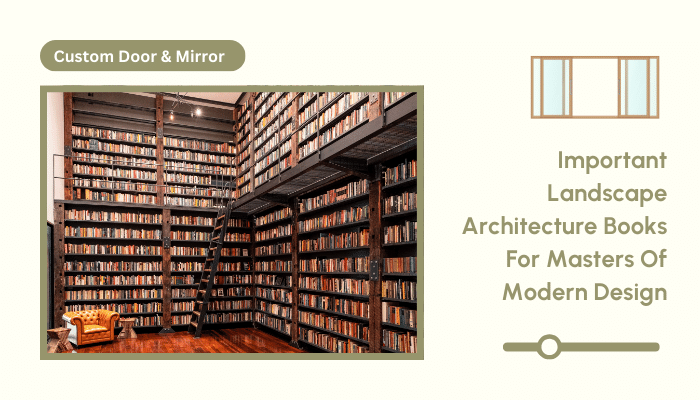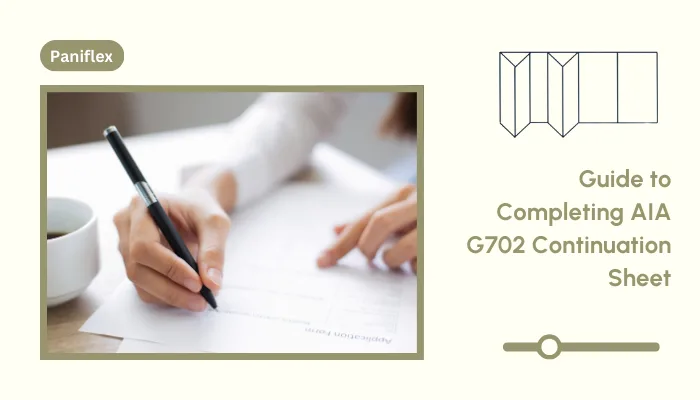When was the last time a book shifted your perspective on design or gave you insights that directly influenced your work? As professionals shaping spaces and crafting environments, you understand the power of knowledge to enhance both creativity and execution.
Ready to experience the benefits of custom closet doors? Explore our range of Paniflex products now.
This blog delves into a curated selection of transformative books that every landscape architect, designer, and contractor should consider exploring. From ecological planning to urban design and aesthetic philosophies, these books are not merely resources—they’re tools to shape your vision.
What timeless insights does “A Pattern Language” bring to your designs?
Christopher Alexander’s “A Pattern Language: Towns, Buildings, Construction“ is a cornerstone in understanding how patterns govern human interactions with spaces.
The book provides a practical framework for designing environments that prioritize functionality, sustainability, and harmony with human behavior. What makes it especially compelling is its approachability—transforming complex design principles into actionable insights.
Imagine standing at a site where a chaotic cityscape meets serene open land. This book equips you to identify and implement patterns that seamlessly connect these elements into a cohesive design. Its emphasis on sustainability and user-centricity ensures its relevance for contemporary projects.
How does “Design with Nature” shape ecological planning today?
Ian McHarg’s “Design with Nature“ is often hailed as the bible of ecological planning. Published in 1969, its message resonates now more than ever.
McHarg emphasizes designing landscapes that harmonize with natural processes—a concept increasingly critical in the face of climate change and urban sprawl.
For instance, consider a project involving stormwater management in a dense urban area. McHarg’s methodologies advocate for leveraging the site’s natural features rather than overriding them, resulting in solutions that are both cost-effective and environmentally sound.
It’s a must-read for those seeking to blend functionality with ecological responsibility.
Why is “The Social Life of Small Urban Spaces” a must-read for designing public spaces?
William H. Whyte’s “The Social Life of Small Urban Spaces“ explores how people interact within urban environments. His groundbreaking research in New York City revealed that the success of public spaces hinges on small yet crucial details—like seating arrangements, shade, and social dynamics.
Picture a bustling urban square. Why are some corners alive with activity while others remain empty? Whyte’s insights can transform how you approach urban design, teaching you to create spaces that invite interaction and foster community. This book bridges the gap between technical design and human-centered planning.
What can “Planting: A New Perspective” teach you about sustainability in landscape design?
Co-authored by Piet Oudolf and Noel Kingsbury, “Planting: A New Perspective“ challenges traditional planting design with its emphasis on naturalistic aesthetics. By focusing on perennial plantings, biodiversity, and ecological balance, this book encourages designers to rethink how greenery functions within a landscape.
Imagine a garden that changes with the seasons yet remains visually striking year-round. This book empowers you to craft sustainable, low-maintenance landscapes that not only captivate the eye but also support ecological health. It’s a valuable resource for those looking to integrate design with environmental stewardship.
How does “The Death and Life of Great American Cities” redefine urban planning?
Jane Jacobs’ “The Death and Life of Great American Cities“ is as much a manifesto as it is a critique of modernist planning. Jacobs dismantles the rigid, car-centric approaches that dominated mid-20th-century urban design, championing walkability, diversity, and vibrant public spaces instead.
As a contractor or designer, this book equips you to prioritize human-scaled neighborhoods that thrive on connectivity and adaptability. Jacobs’ ideas continue to influence the principles of new urbanism, making her work indispensable for anyone involved in urban and landscape design.
Also read: The Evolution Of Architecture: How Design Has Changed Over Time?
How does “The Landscape Urbanism Reader” redefine the relationship between cities and nature?
Edited by Charles Waldheim, “The Landscape Urbanism Reader” is a compilation of essays that challenge conventional notions of urban design. It introduces the concept of landscape urbanism, where the landscape is no longer a backdrop but a primary medium for shaping cities.
Imagine tackling a project in a high-density urban area. How do you integrate natural systems into an already congested environment? This book offers a wealth of ideas and case studies that can guide you in weaving ecological elements into urban frameworks, creating spaces that are both functional and resilient.
Why is “Landscape Architecture: A Manual of Environmental Planning and Design” an indispensable guide?
John Ormsbee Simonds and Barry Starke’s “Landscape Architecture: A Manual of Environmental Planning and Design“ has been a foundational text for decades. This comprehensive manual covers the entire design process, from initial site analysis to detailed construction documentation.
Whether you’re a seasoned professional or a student, this book serves as both a textbook and a reference guide. It dives deep into topics such as sustainable site planning, water management, and ecological restoration, offering actionable insights for creating landscapes that balance human needs with environmental concerns.
How does “Thinking Architecture” inspire a sensory approach to design?
Peter Zumthor’s “Thinking Architecture“ explores the emotional and sensory dimensions of architecture and landscape design. This collection of essays invites you to think beyond technicalities and delve into the human experience of spaces.
For instance, have you ever walked through a garden where every detail—from the rustling leaves to the dappled sunlight—felt intentional? Zumthor’s writing encourages you to design with a similar sensitivity, ensuring that your projects resonate deeply with their users.
Also Read: Unlocking The Emotional Architecture Power: A Guide For Architects
What lessons does “Silent Spring” offer to landscape architects today?
Rachel Carson’s “Silent Spring“ is a call to action that remains profoundly relevant. Published in 1962, the book highlights the devastating effects of pesticides on ecosystems and serves as a rallying cry for sustainable practices.
As a landscape architect, Carson’s work is a reminder of the environmental impact of every decision, from material selection to planting strategies. By prioritizing ecological health, you can create landscapes that not only serve human needs but also nurture the natural world.
Why should “Drawing for Landscape Architecture” be on your bookshelf?
Edward Hutchison’s “Drawing for Landscape Architecture“ bridges traditional and digital drawing techniques, making it an invaluable resource for communicating design ideas. The book emphasizes the importance of hand drawing as a tool for observation and conceptualization, even in the digital age.
Think about the initial stages of a project. How do you translate an idea into a visual form that clients and collaborators can understand? This book provides practical guidance for creating clear, compelling representations that effectively convey your vision.
How does “The Architecture of Community” advocate for human-centered urbanism?
Leon Krier’s “The Architecture of Community” offers a powerful critique of modernist planning and presents a vision for designing human-scale neighborhoods. His ideas emphasize traditional architectural principles and walkable, mixed-use communities.
As a practitioner, this book challenges you to rethink large-scale developments and prioritize designs that foster social connections. It’s a valuable resource for anyone involved in urban design or large residential projects.
What practical insights does “Site Planning and Design Handbook” provide?
Thomas H. Russ’s “Site Planning and Design Handbook“ is a go-to resource for navigating the complexities of site planning. Covering everything from zoning laws to environmental impact assessments, this book ensures no detail is overlooked.
Imagine you’re tasked with designing a mixed-use development. This handbook provides step-by-step guidance for balancing technical requirements with aesthetic considerations, helping you deliver projects that are both compliant and visually appealing.
How does “The New Urbanism” guide sustainable community development?
Peter Katz’s “The New Urbanism: Toward an Architecture of Community“ introduces the principles of the new urbanism movement, which emphasizes creating walkable, sustainable communities. This book provides a historical overview and actionable strategies for implementing these principles in real-world projects.
As a designer or contractor, this book equips you to champion projects that prioritize human connection and environmental sustainability. Whether you’re working on a small residential neighborhood or a large urban redevelopment, Katz’s insights are invaluable.
What can “Islamic Gardens and Landscapes” teach us about cultural and historical contexts?
D. Fairchild Ruggles’ “Islamic Gardens and Landscapes“ explores the rich history and symbolism of Islamic gardens. This book dives into the interplay of culture, agriculture, and water management, offering lessons that transcend time and geography.
Imagine designing a public park that draws inspiration from historical precedents. Ruggles’ work can guide you in integrating traditional design elements with modern functionality, creating spaces that honor their cultural roots while serving contemporary needs.
Ready to experience the benefits of custom closet doors? Explore our range of Paniflex products now.
Also read: Innovation In Architecture: Embracing Technology To Shape The Future Of Design.
Conclusion
This curated selection of books offers a wealth of knowledge and inspiration for landscape architects, designers, and contractors. Each title delves deeply into specific aspects of the field, providing both practical tools and conceptual frameworks to elevate your work. Whether you’re revisiting a classic or discovering a new perspective, these books are invaluable companions on your journey to mastering modern design.
Enhance your projects with Paniflex’s custom solutions
Looking to complement your designs with precision-engineered, custom closet doors? Paniflex specializes in bespoke bifold and sliding doors tailored for architects, interior designers, and contractors.
With over 60 years of expertise, Paniflex offers innovative solutions that fit seamlessly into any space, eliminating the need for structural modifications. The cutting-edge manufacturing process ensures every door meets exact specifications, delivering both style and functionality.
Explore Paniflex to elevate your projects with floor-to-ceiling and wall-to-wall designs that maximize space and bring your creative vision to life.
Visit Paniflex to learn more and access detailed installation resources for effortless integration into your next project.






